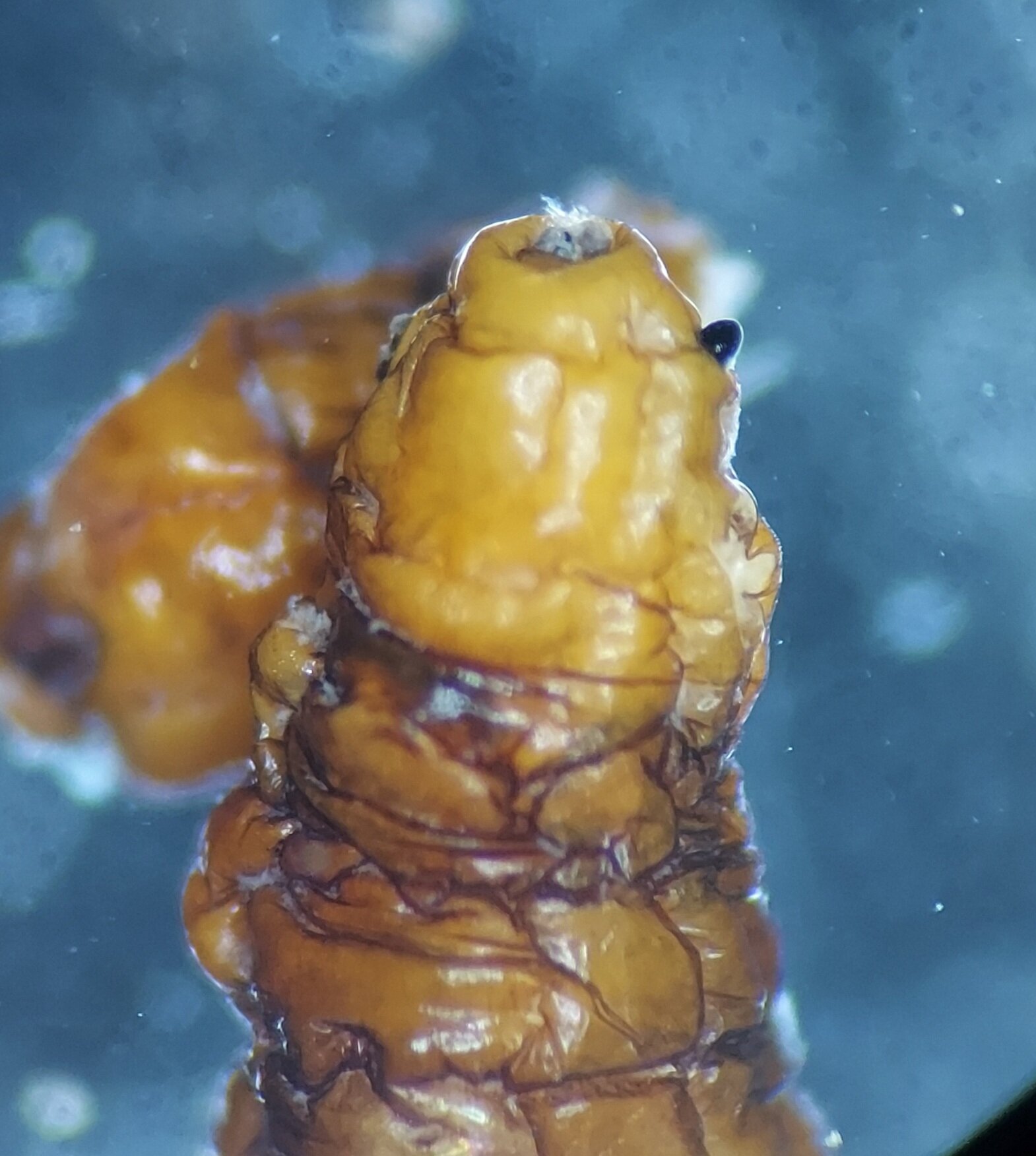I’ve been working through the backlog of unidentified centipedes in the Virginia Natural History Museum collection over the past year, and I found something very strange and cool yesterday: an internal parasite in a centipede collected in Virginia!
Dorsolateral view of the centipede (Nadabius pullus), with internal parasite visible through exoskeleton between segments 8-12.
The centipede in question was collected on May 22, 2005 by Richard Hoffman in Appomattox County, Virginia and is the common lithobiid Nadabius pullus. Under the scope, it was readily apparently there was something strange about this specimen: it was noticeably bulging in the middle of the body and was very tubular in that region, rather than flattened. So, I started dissecting the mass from the body.
The parasite peeks out of the body cavity (is the black structure an eye? I’ve no idea). Above the centipede is a portion of the parasite already dissected out.
Parasite fully dissected out of the centipede’s body.
After dissecting it out of the centipede, I was greeted with some type of parasite (parasitoid). I damaged it during the dissection, so it’s in two pieces now. The above photo is what I think is the dorsal view.
Ventral view of parasite
This thing is irritatingly non-descript. It’s about 5 mm long and 1.5 mm wide. It’s somewhat leathery, with various wrinkles and furrows. It’s mostly smooth, but does have various small pits and weak striae along the body. The main dorsal structure is a circular dark structure (see bottom of first full body image). Ventrally it has two large, cylindrical black structures that are smooth and widely separated. At the opposite end, it has a pair of dark structures which were sticking out of one of the posterior spiracles of the centipedes, but these were damaged during the dissection.
Close up of the paired black cylindrical structures, ventral side of parasite.
Dorsal view, showing structures at tip of body. I’ve tried to clean off the gunk around the structures, but gave up to avoid damaging them.
I’ve asked around and sent photos to my colleagues to see if anyone recognizes this thing, but no dice so far (from entomologists at least). Additionally, the search is hobbled by the lack of data we have on centipede parasites. We only know of a few arthropod parasites of lithobiomorph centipedes, which are limited to the Diptera and Hymenoptera (see Lewis 1981 for a summary).
Tachinid flies are the most well-documented lithobiid parasites, with two species known to parasitize stone centipedes: Eloceria delecta (Meigen, 1824) and Loewia foeda (Meigen, 1824). Both of these species are Palearctic and specialize on the European native centipede Lithobius forficatus (Linnaeus, 1758). Thompson (1939) conducted a study of 300 L. forficatus specimens from southern England and Paris, France, and found a parasitism rate of 7.5%. He reported two species of Tachinids, an unknown one and L. foeda.
In North America, Lithobius forficatus is a common introduced species in urban environments and disturbed woodlands. Crossing an ocean hasn’t removed the threat of parasitism, however, as Wood & Wheeler (1972) documented the presence of L. foeda in North America for the first time. They collected two specimens of the fly from Long Island and Ithaca, New York. Recently, Haraldseide & Tschorsnig (2014) described additional facets of the biology of this species and included descriptive notes of the puparium for the first time.
Less is known about the Hymenopteran parasites of stone centipedes. The only documented example I could find was Phaneroserphus calcar, a European Proctotrupid wasp. Newman (1867) colorfully described 14 larval P. calcar pupating and emerging from a Lithobius forficatus specimen brought to him by a friend. Apparently this is a common European species and it also parasitizes Staphylinids (Townes & Towes, 1981).
I don’t think it’s a Proctotrupid, based on the presence of only one parasite inside this centipede. My best guess is one of the Dipteran parasites, but that’s still a gamble. At any rate, this is the first documented case of parasitism in a native North American lithobiid that I’m aware of, which is pretty neat. I only live a few hours away from where this specimen was collected, so I’m going to take a trip or two out there in the future to see if I can find anymore. Maybe a fresh specimen will look more recognizable. Stay tuned for updates, and check your centipedes for weird roommates.
References:
Haraldseide, H. & Tschorsnig, H.P. 2014. On the biology of Loewia foeda (Meigen) (Diptera: Tachinidae). The Tachinid Times, 27: 15-19. https://www.uoguelph.ca/nadsfly/Tach/WorldTachs/TTimes/Tach27.html
Lewis, John G.E. 1981. The biology of centipedes. - Cambridge University Press, Cambridge: 476 pp.
Newman, E. 1867. A Proctotrupes parasitic on a myriapod. The Entomologist, 46: 342-344. https://www.biodiversitylibrary.org/page/11931840
Thompson, W.R. 1939. Biological control and the theories of the interactions of populations. Parasitology, 31: 299-388.
Townes, H. & Townes, M., 1981. A revision of the Serphidae (Hymenoptera). Memoirs of the American Entomological Institute. 32: 1-541.





